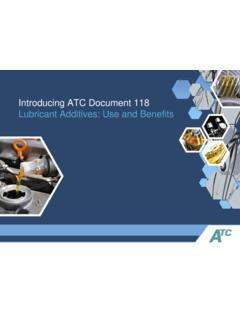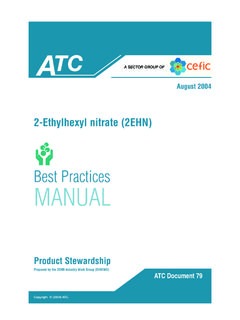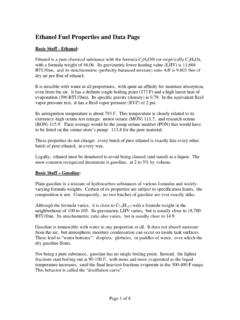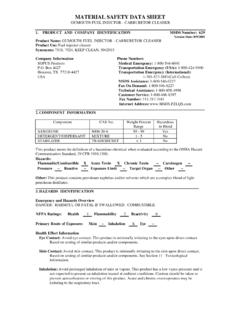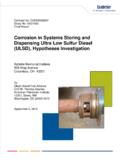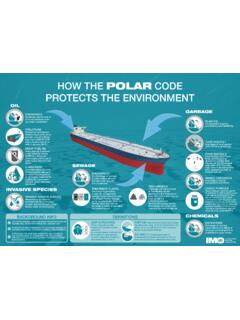Transcription of LUBRICANTADDITIVES and THE ENVIRONMENT
1 1 LUBRICANT ADDITIVESandTHE ENVIRONMENTATC Document 49 (revision 1)December 20072 Lubricant additives and the EnvironmentABSTRACTThe Technical Committee of Petroleum Additive Manufacturers in Europe(ATC) hascarried out an analysis ofthe size and nature of the engine lubricants market in the 15countries ofthe European Community (EU-15).The first edition of this study was prepared in 1993 andwas conducted to develop information which was notpreviously available, with the purpose of putting in perspective the benefits to the ENVIRONMENT and the end-userprovided by lubricant additive edition (2007) updates the information and reanalyses the the chemistry and functions of lubricant additives , as well as their role in thedevelopment of advanced engine health and safety environmentalfate of crankcase lubricant additives is explored, and a mass balance from cradleto graveis paper has been prepared by a task force onbehalf of the ATC-The Technical Committee ofPetroleum Additive Manufacturers in petroleum additive industry is developingtechnologies and materials for the supply of serviceproducts for engines and motor vehicles, in co-operation with the petroleum and automotiveindustries.
2 Amongst the activities of the industry are very wellknown to its customers in the oil industry and to itsindirect customers in the motor industry, there isvery little public domainliterature aresult, it is sometimes difficult to answer relativelysimple questions from government regulators andothers who feel a need to knowmore about ourindustry and particularly its impact on aim of this paper is to introduce ATC, toexplain how the association operates, and todemonstrate the contribution lubricant additivesmake towards industry, the consumer and ultimatelythe answering questions, the paperhopes to allowindustry and regulators to focus on the priorities forfuture attention rather than things which are trivialor already well itself to a study ofautomotive crankcase oil additives , their chemistry,the benefits they provide andtheir fate in crankcase oil additivescomprise those used in passenger car diesel andgasoline engine lubricants (PCMO-passenger carmotor oil) and in bus and truck diesel enginelubricants (HDDO-heavy duty diesel oil).
3 The study isbased mainly on the 15 EuropeanCommunity members (as of April 2004)comprisingAustria, Belgium,Denmark, Finland, France,Germany,Greece,Ireland,Italy,Luxe mburg,Netherlands, Portugal, Spain, Sweden and the choice was based on the availability of thewidest range of data to allow cross checking Technical Committee of Petroleum AdditiveManufacturers in Europe (ATC) was established in1974 for member companies to discuss topics of atechnical and statutory nature which were a concernto their current members are shown information about ATC can befound on the ChemicalBaker PetroliteBASFC hemtura CorporationChevron OroniteCIBA Specialty ChemicalsCrodaEvonik RohMax additives GmbHInfineumInnospec Fuel of ATCM embership is open to all additive companieswhichoperatechemicalprocessesfo rthemanufacture of petroleum additives , or havecomprehensive test facilities in 1979, ATC became affiliated as an industrysector group of Cefic.
4 A federation of associationsrepresenting European chemical organisation and objectivesThe ATC organisation comprises a main committeeandsub-committees responsible for Health, Safety and Legislation Lubricant Performance Testing Fuels Quality Monitoring External representation and strategyIn addition,theTechnische Vereinigungf rMineral l-Additive in Deutschland (TAD)co-ordinates activities for ATC in objectivesof ATCare: To provide a forum for additive companies tomeet and discuss developments of a technicaland/orstatutorynatureconcerning themanufacture orapplication of additives in fuels,lubricants and other petroleum products. To ensure dissemination of ATC views torelated international and national technicalgroups and organisations.
5 To participate in work of a technical nature inconjunction with associated industry orstatutoryorganisations or example, ATC has developed descriptiveterminology for products to assist legislators byproviding standardised industry reporting whilstprotecting data are sharedto provide accurate labelling of products recently ATC has activelyparticipatedindiscussionsonaspec tsofenvironmentallegislationincludingREA CH(Registration Evaluation andAuthorisationofChemicals).By communicating with associated industries andtechnical bodies ( ACEA,AssociationdesConstructeurs Europ ens d Automobiles; CEC,CoordinatingEuropeanCouncilfortheDev elopment of Performance Tests for Lubricantsand Engine Fuels; ATIEL,Association Techniquede1 IndustrieEurop endesLubrifiants.)
6 CONCAWE,TheOilCompanies EuropeanOrganisationforEnvironmentalandH ealthProtection)technicalissues can be pursued anddeveloped for mutual ATC alsoprovides a focal point for the industry tocommunicate with petroleum additive industryThe petroleum additive industry is a research anddevelopment intensive industry and its products aremarketed solely to industrial key factsabout the petroleum additive industry are: World-wide the industry spends about 400million/annum(2005)onresearchanddevel opment, of which 115 million is spent inEurope (EU-23). World-wide the industry has a turnover of about 7,000million ofwhich the European market isabout 1,900 The industry employs directly about2,800people inEurope and about 8,400 globally.
7 The industry operates more than 25 research anddevelopment establishments and manufacturingsites in Europe, and more than 75 globally. The petroleum additive industry in Europe is amajor member company objectives include thedevelopment of additives for fuels and lubricants inco-operation with the oil and motor industrieswhich meet present, and future performance andenvironmental legislation cost-effectively and whichsolve or mitigate both existing and anticipatedproblems of vehicle or engine automotive crankcase lubricant additivebusinessAll automotive crankcase lubricants need additives ,at total concentrations (as sold) of typically 10-30%.Lubricant additives help provide theperformance necessary for efficient operation andprolonged engine single additive component can do additive components are needed to change as engine design, operatingconditions, legislation,and sourceof supplyandprocessingmethods of the base oil components of different chemistryareused, at concentrations (in the finished lubricant)from to more than 10%.
8 The particularcombination of additive components used in anautomotive engine oil is generally known as anadditive customer (an oil company)specifies the performance requirements of thefinished petroleum additive supplierevaluates combinations of additive componentsuntil therequiredperformance is package is then offered for sale withoutdisclosing proprietary details of its of a new lubricantNew lubricants are developed to meetboth changesin, and new, Original Equipment Manufacturer(OEM) needs, or consumer , a new engine design configuration mayrequire improved lubricant , adifferent service application or lubricant requirements are identified andnew or existing engine tests andother evaluations ofphysical characteristics or performance propertiesmay be prescribed to ensure these requirements lubricant marketer identifies the necessaryproduct characteristics to meet the consumer requirements,together with technicaltargets,areevaluatedby the additive companieswho then carry out the engine tests necessary todevelop the many cases these test datawill be presented to an industry body or an OEM forlubricant completion, the new lubricant (containing theadditive package)
9 Will be offered for sale therebysatisfying the OEM and market-place , complexity and confidentialityThe costs of engine testing are high becausecomprehensive documentation and statistically validdata are example, the engine testdevelopment costs for a crankcase lubricant suitablefor use in today s European and US diesel andgasoline engines are at least of in-house data and formulation latter are extremely important as many of therequirements are conflicting ( useof an additiveto improve Test A could make TestB worse).Apart from running engine tests, extensive fieldtests in vehicles, often extending to millions ofkilometres, are needed to guarantee meet the ever-changing needs of the enginedesigner and of the consumer,alwayswith respectto environmental concerns, the additive industryputs a major effort into developing the products of these developments fail to meet theirtechnical targets.
10 But some pass all the tests andbecome additiveindustry spends more than 115million/year inEU-23on new single component cancost between one andtenmillionEurosto developand the cost of development plus that of the5manufacturing plant cantake ten to fifteen years cost of compliance with health andsafety legislation has risen over the years, and willincrease still further when REACH is additive companies require considerablefinancial investment and the innovative skill of theiremployees to develop additive components are selling performance productsand not do not disclose thecomposition of additive packages, as the results oftheir investment in research and development wouldbe available to anyone having access to compositions were disclosed, s engines will not function onyesterday s s engines will neednew additive in fueleconomy alone will require additive developmentstomeet higher engine temperatures andlowerfrictionrequirements as well ascompatibility withnew , for various reasons offer only limitedprotection-one being the difficulty of policing dueto problems of ofcomponents in an additive package to achieve therequired performance may not be readily.

